 |
| The west front, Beddington Park from Select Illustrations of the County of Surrey by GF Prosser (1828) |
I grew up in Carshalton, Surrey (well, technically it is in the London Borough of Sutton, but I still like to think of it as Surrey), and recently revisited one of the local green spaces – Beddington Park. As ever, when I go places these days, I am looking for the Georgian connection. I knew that there was a big gated house in Beddington Park that was now a school and I discovered that it dates from the early 18th century.
 |
| Carew Manor through the gates (2019) |
The house is named Carew Manor after its long-term owners. Prosser’s Select Illustrations of the County of Surrey (1828) says:
Beddington has been the family residence of the Carews from as early a period as the reign of Edward the Third, when Nicholas de Carru was keeper of the Privy Seal, and was one of king Edward’s executors.1
One of the original Nicholas's descendants, Sir Nicholas Carew, was a gentleman of the privy chamber of Henry VIII. It appears that the king visited Beddington Park on several occasions whilst Sir Nicholas was in favour, allegedly to secretly visit Anne Boleyn and later Jane Seymour. In 1539, Sir Nicholas, already out of royal favour, was charged with a conspiracy against the king and executed, and his lands were confiscated.
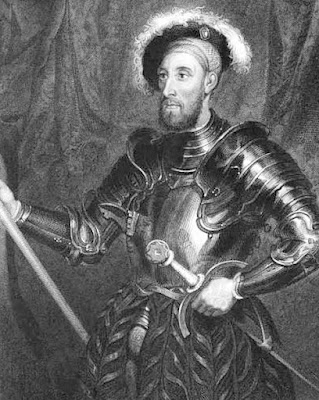 |
| Sir Nicholas Carew from Portraits of Illustrious Personages of Great Britain by E Lodge (1835) |
Sir Francis Carew (c1530-1611)
Sir Nicholas’s son Francis managed to win Queen Mary’s favour and had most of his father’s lands restored to him. Beddington Park was an exception; he had to buy it back from the then owner, Thomas Darcy, 1st Baron Darcy of Chiche.
According to Prosser, Sir Francis
... rebuilt the mansion in a magnificent manner, laid out the gardens, and planted them with choice fruit trees, in the cultivation of which he took great delight, and spared no expense in procuring them from foreign countries. The first orange trees in England are said to have been planted by him. Aubrey says he brought them from Italy, but the Editors of the Biographia Britannica, under the article of Raleigh, say, from a tradition preserved in the family, that Sir Francis raised them from seeds of the first oranges, which were imported into England by Sir Walter Raleigh, who had married his niece, the daughter of Sir Nicholas Throckmorton. Be this as it may, the trees were planted in the open ground, and were preserved in the winter by a moveable shed. In 1690 most of the trees were 13 feet high, and it is said at least 10,000 oranges were gathered from them that year. They flourished about a century and a half, but were destroyed by the hard frost in 1739. In the garden was a pleasure house, on the top of which was painted the Spanish Armada.2
Sir Francis was visited by Queen Elizabeth I several times:
In August 1599 Queen Elizabeth paid a visit of three days to Sir Francis, and again in the same month in the ensuing year. The queen’s oak and her favourite walk are still pointed out.3
Sir Francis died childless in 1611, bequeathing Beddington to Nicholas Throckmorton, the youngest son of his sister Anne, who assumed the surname Carew.
Sir Nicholas Carew, 1st Baronet (1687-1727)
Several generations later, in 1689, Beddington Park was inherited by another Nicholas when he was little more than a baby. This Nicholas became Member of Parliament for Haslemere in the first parliament of George I and was made a baronet in 1715.4
It was during his ownership of Beddington Park that the house was largely rebuilt. The Tudor Great Hall, which dates to around 1510, with its Gothic wooden hammer-beam roof, was retained and is now Grade I listed.
A lack of heirs and financial ruin
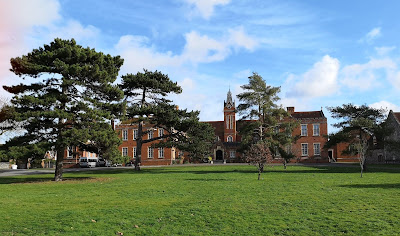 |
| Carew Manor (2019) |
Sir Nicholas was succeeded by his son, Sir Nicholas Hackett Carew, who died without male heirs in 1762 and the baronetcy became extinct.
The estate was then inherited by a distant relative, Richard Gee, who took the name and arms of Carew by Act of Parliament in 1780. However, Richard died unmarried in December 1816 and left his entire estate to Anne Gee, his widowed sister-in-law.
When she died without issue in 1828, Beddington was inherited by her cousin Admiral Sir Benjamin Hallowell, who added the name and arms of Carew to his own. He was an officer at the Battle of the Nile under Vice Admiral Horatio Nelson and was the owner of Beddington Park when Prosser was writing in 1828.
When she died without issue in 1828, Beddington was inherited by her cousin Admiral Sir Benjamin Hallowell, who added the name and arms of Carew to his own. He was an officer at the Battle of the Nile under Vice Admiral Horatio Nelson and was the owner of Beddington Park when Prosser was writing in 1828.
The house was lost to the family in the 1850s due to financial difficulties and became home to the Royal Female Orphanage from 1866 to 1968. It now houses a school, Carew Academy.
A description of Beddington Park in 1828
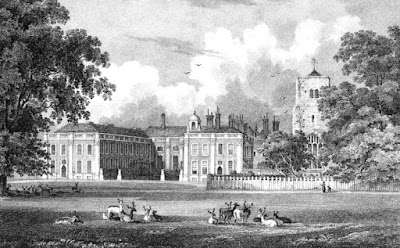 |
| Beddington Park from Select Illustrations of the County of Surrey by GF Prosser (1828) |
The west front of the present mansion is represented in the annexed view, consisting of three sides of a square. It was built about 1709. The centre is a noble hall 61 feet 5 inches in length, by 32 feet in width. The height from the floor to the apex of the beautiful gothic roof of wood, is 46 feet 2 inches. The roof is evidently of greater antiquity than the other portion of the building, and is said originally to have been intended by king Henry to adorn a palace for his favourite Wolsey, but was afterwards given to Sir Nicholas Carew. The oak panelling is embellished by a display of arms, flowers, &c. The great entrance door has a curious ancient lock, very richly wrought; a shield, with the arms of England, moves in a grove, and conceals the key-hole; tradition says this lock to have been presented by queen Elizabeth. Many well-painted family portraits adorn the walls, the most remarkable of which is that of Sir Nicholas Carew who was beheaded; it is a copy painted on board, and bears date 1578. The furniture has been judiciously chosen by the present possessor, in strict accordance with the ancient style of the building, and the coup d’œil on entering this apartment is very imposing.The north wing was originally designed for the state apartments, but was destroyed by fire shortly after it was built, and now remains a mere shell, never having been restored. In 1817 the south wing was repaired, and several of the principal apartments modernized. A small room adjoining the great hall (now a butler’s pantry) retains the ancient panels with mantled carving. In the dining-room are portraits of several naval officers.The grounds retain many of the characteristics of the old school of gardening. A waterfall forms a prominent object on the east side; supplied by the river Wandle, which rises at Croydon and intersects this park in its course to the Thames.At a short distance westward of the house is a spacious canal, supplied from the same river; on each side are rows of venerable elms; parallel with these, and opposite the west end of the church, as seen in the view, is a fine avenue of chestnut trees, of luxuriant growth; near the house, to the north-west, are some remarkably fine walnut-trees. The park is flat, but is much enlivened by numerous herds of fine deer, browsing under the shade of the stately trees which adorn its surface.The church, dedicated to St Mary, consists of a nave, two aisles, and a chancel. The west end has a square tower with buttresses.5
 |
| St Mary's Church, Beddington (2019) |
There is little of the Georgian park remaining as it was largely redeveloped by Alfred Smee in the Victorian period. You can read detailed descriptions of his work in My Garden (1872)6.
However, there is still one Georgian gem to be seen – a magnificent early Georgian dovecote. It was most likely built around 1709 whilst Sir Nicholas Carew, 1st Baronet, was carrying out his rebuilding programme. It is unusually large, with nesting boxes for 1,360 birds built into the walls. This probably provided more birds than the manor needed and so some may have been sold. The birds could fly out through the turret and there were four ventilators to release what must have been an overwhelming odour.
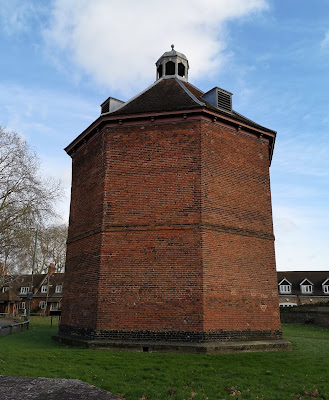 |
| The dovecote, Beddington Park (2019) |
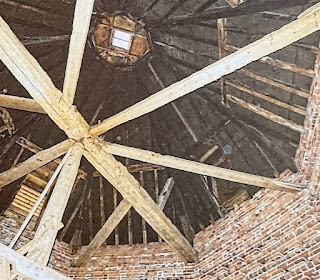 |
| Inside the dovecote, Beddington Park (from signboard) |
 |
| Inside the dovecote, Beddington Park (from signboard) |
It was restored in the 1980s and is now a Grade II* listed building and a scheduled ancient monument.
 |
| The old pigeon-house in Beddington Park from My garden by A Smee (1872) |
Notes
1. Prosser, George Frederick, Select Illustrations of the County of Surrey (1828).
2. Ibid.
3. Ibid.
4. This date from Burke. Prosser says 1814.
5. Prosser op cit.
6. Smee, Alfred, My garden, its plan and culture together with a general description of its geology, botany and natural history (1872).
7. Ibid.
7. Ibid.
Sources used include:
Burke, John and Burke, John Bernard, A Genealogical and Heraldic History of the Extinct and Dormant Baronetcies of England, Ireland and Scotland (1844)
Lodge, Edmund, Portraits of Illustrious Personages of Great Britain Volume I (1835)
Prosser, George Frederick, Select Illustrations of the County of Surrey (1828)
Smee, Alfred, My garden, its plan and culture together with a general description of its geology, botany and natural history (1872)
Beddington Park signboards

Very helpful article.
ReplyDeleteShame that across the road from the entrance to the manor in the cemetery there is a poor testament to the girls of the orphanage. The grave stone in bad condition and hardly visible
ReplyDelete